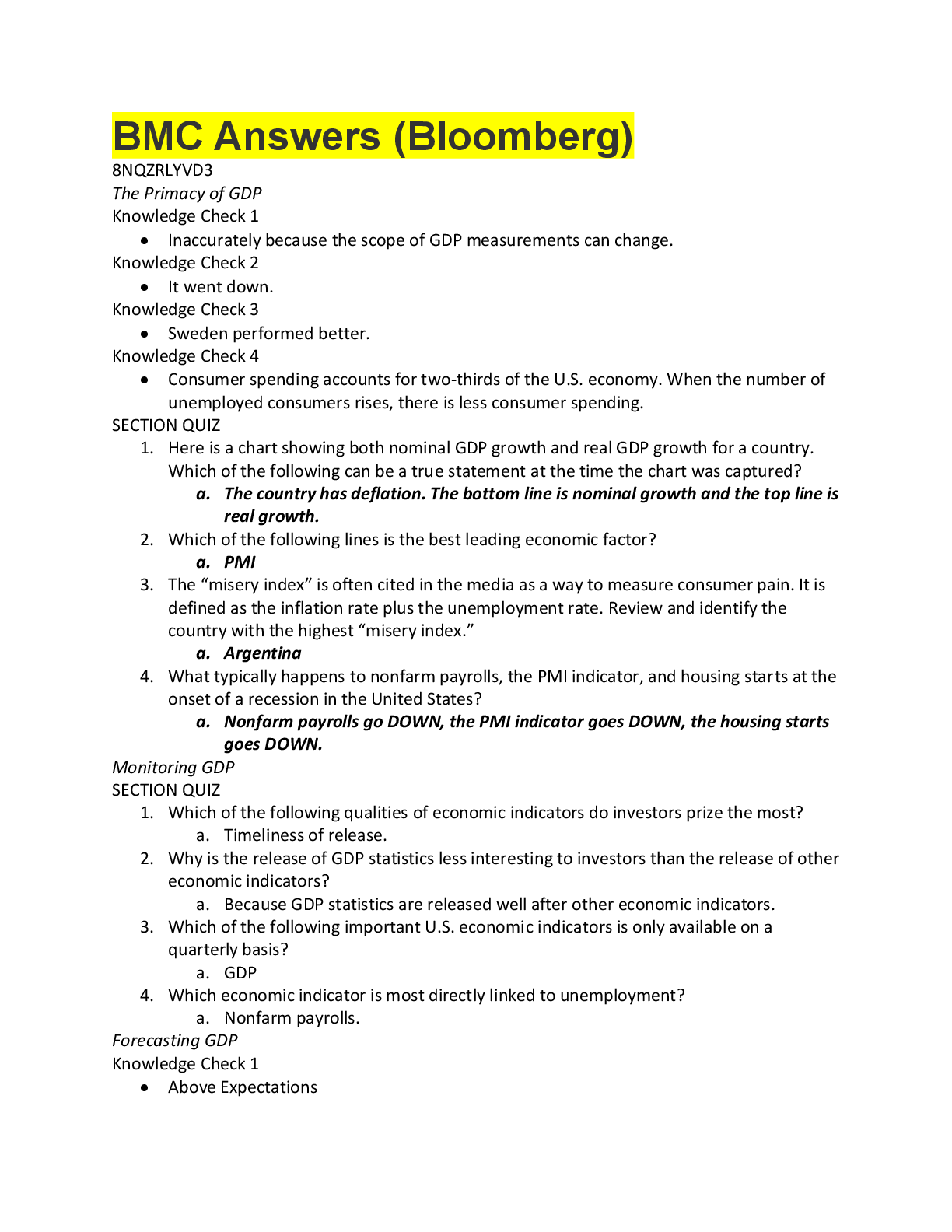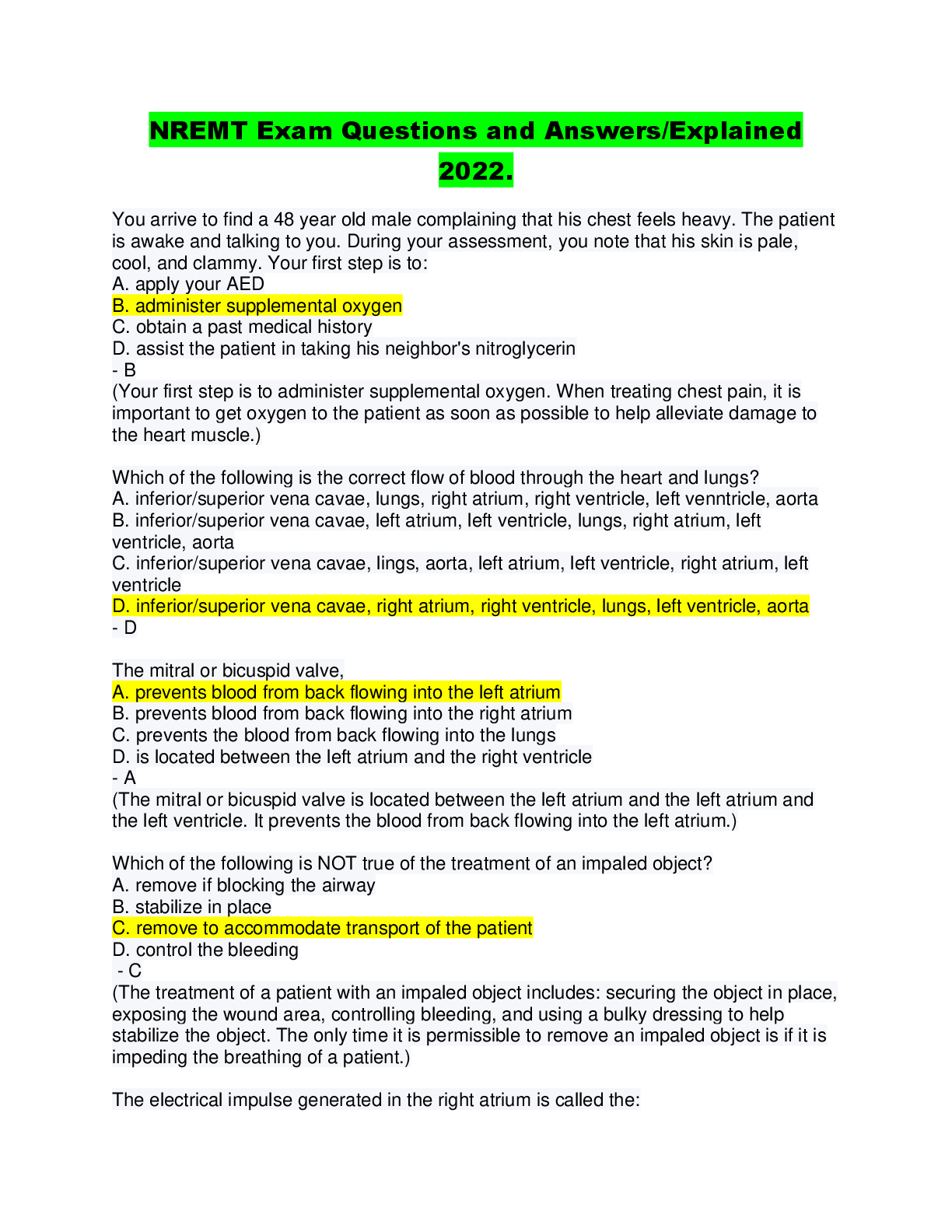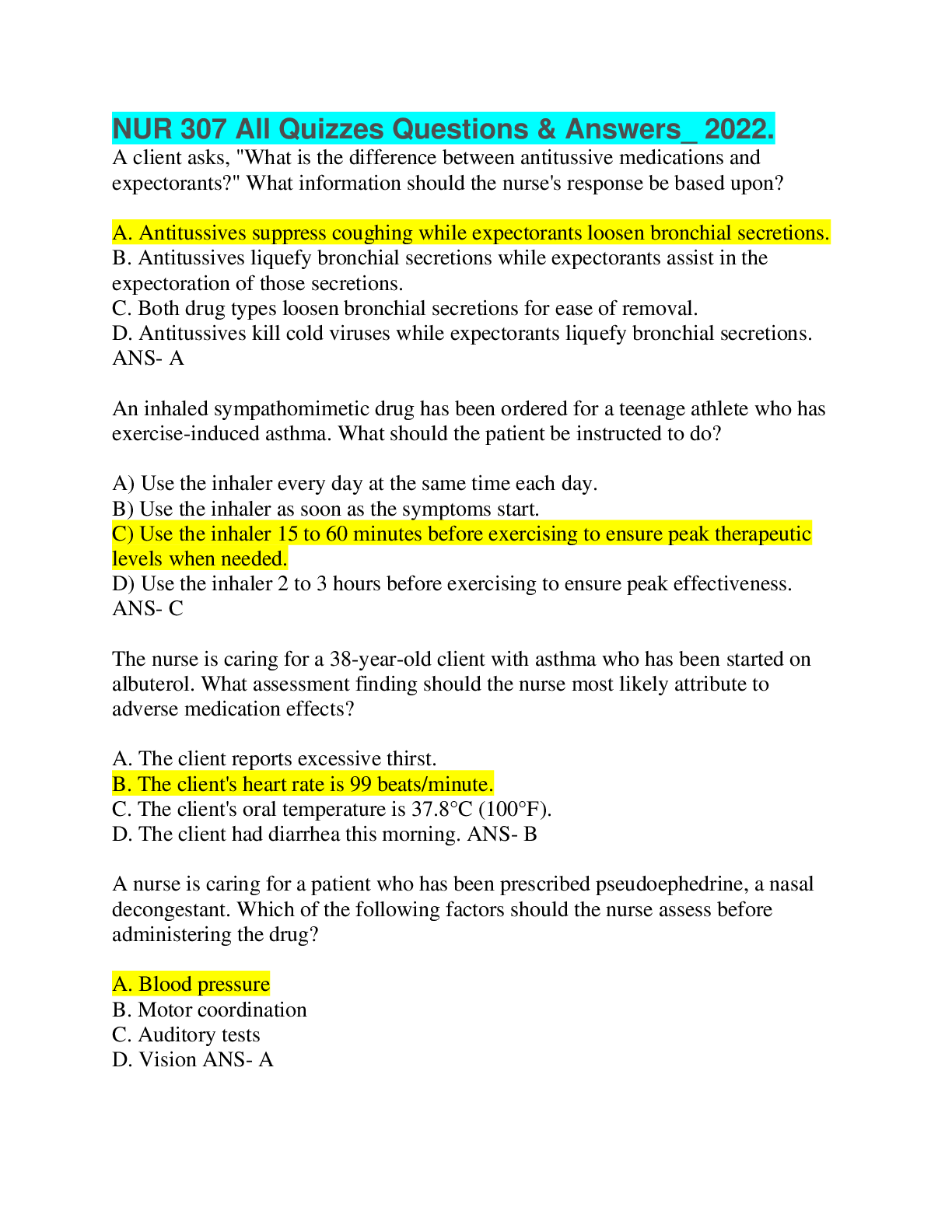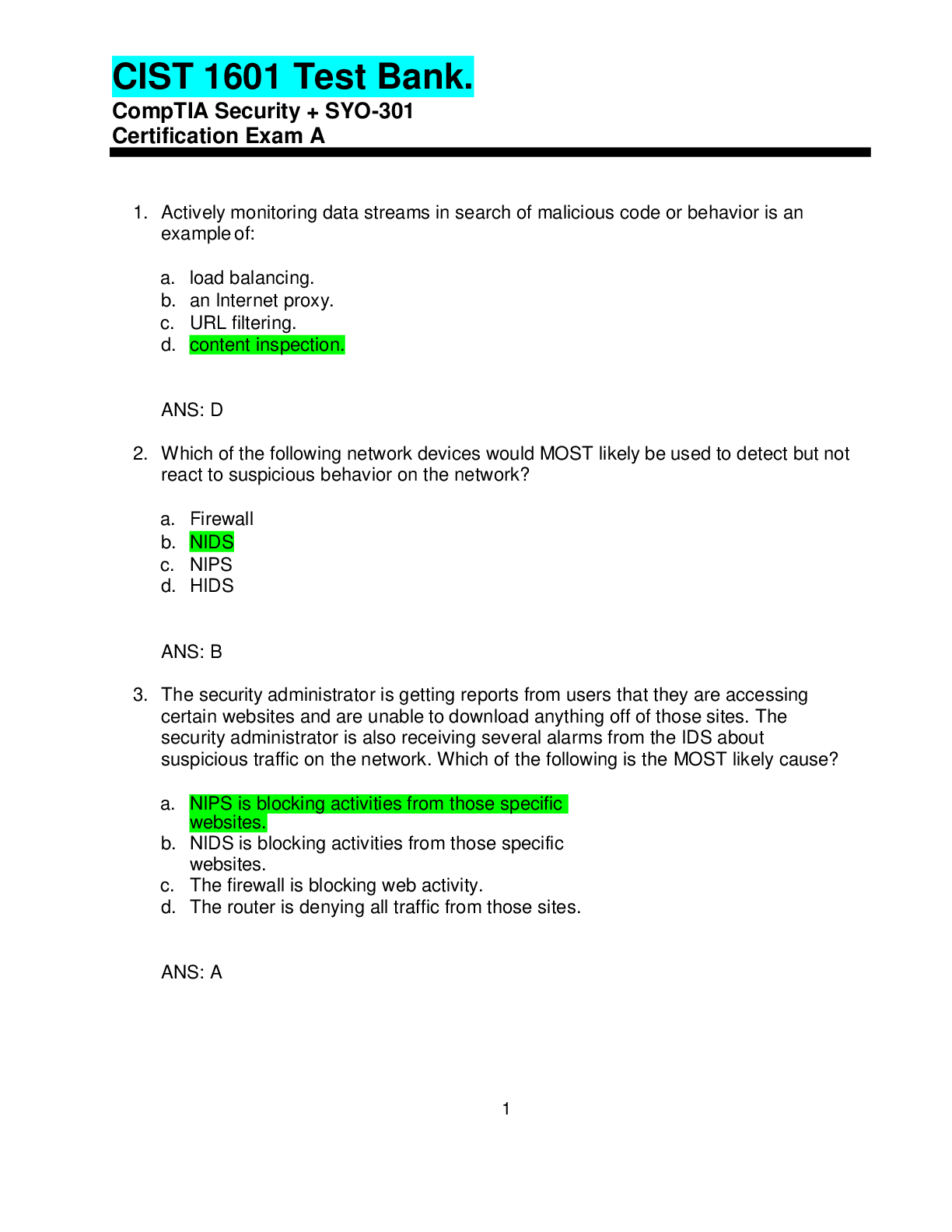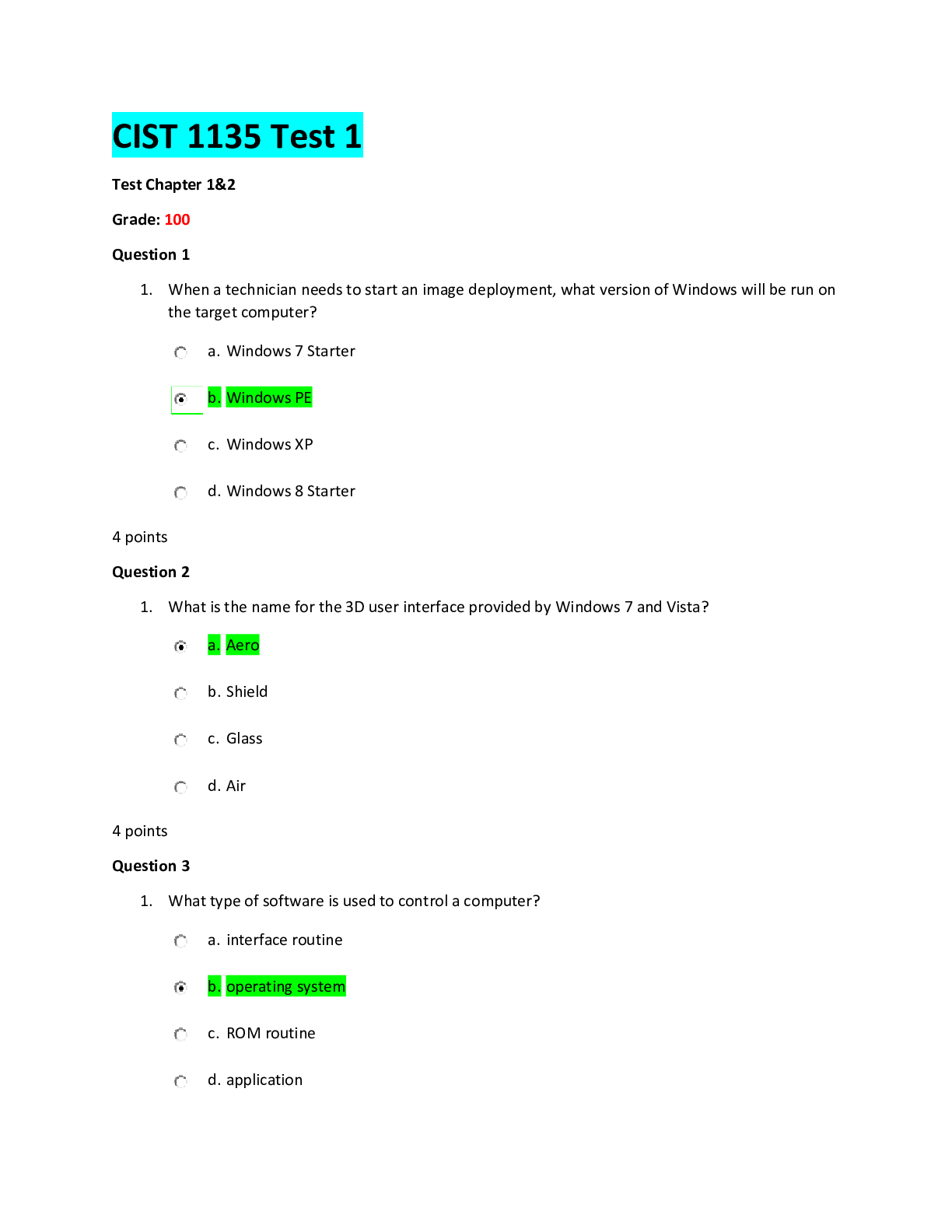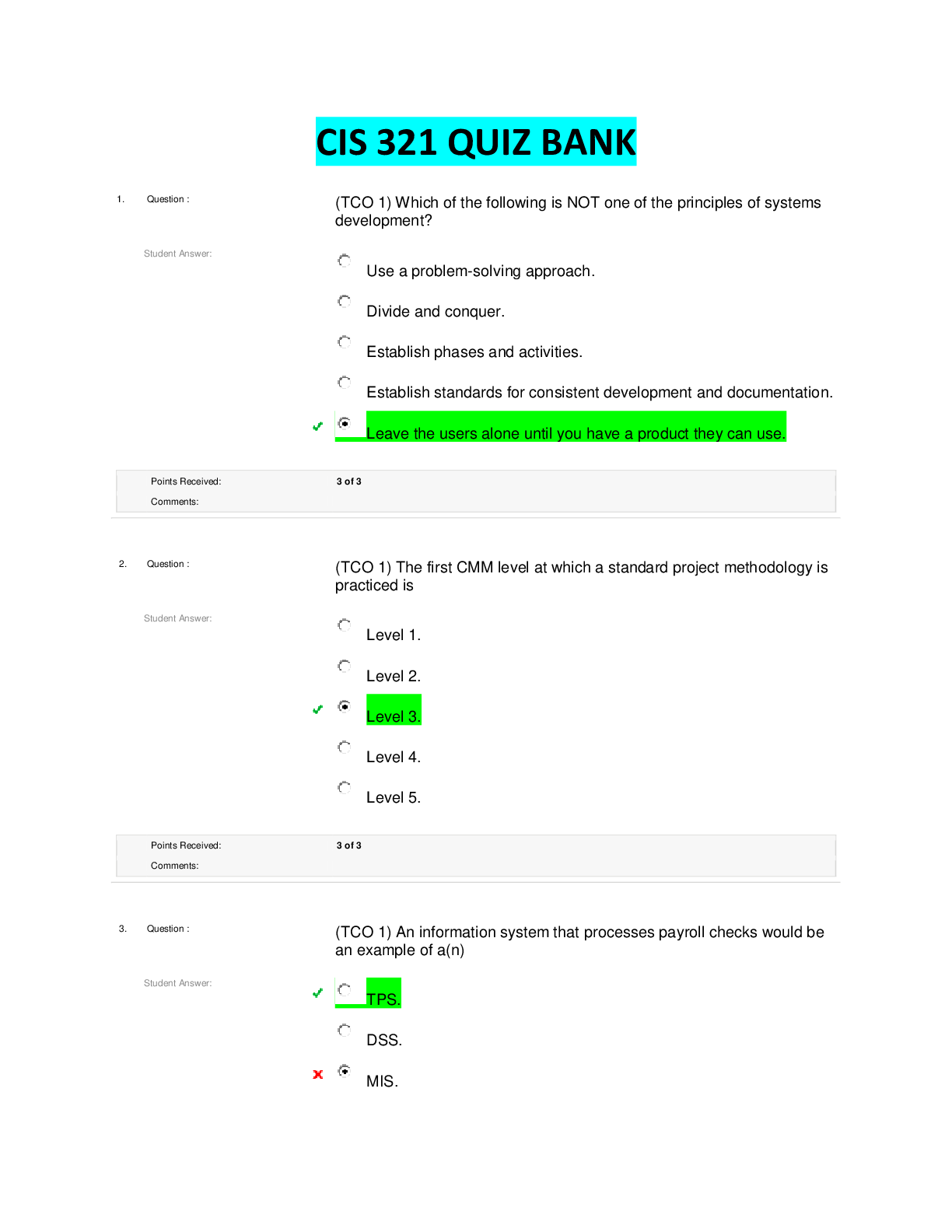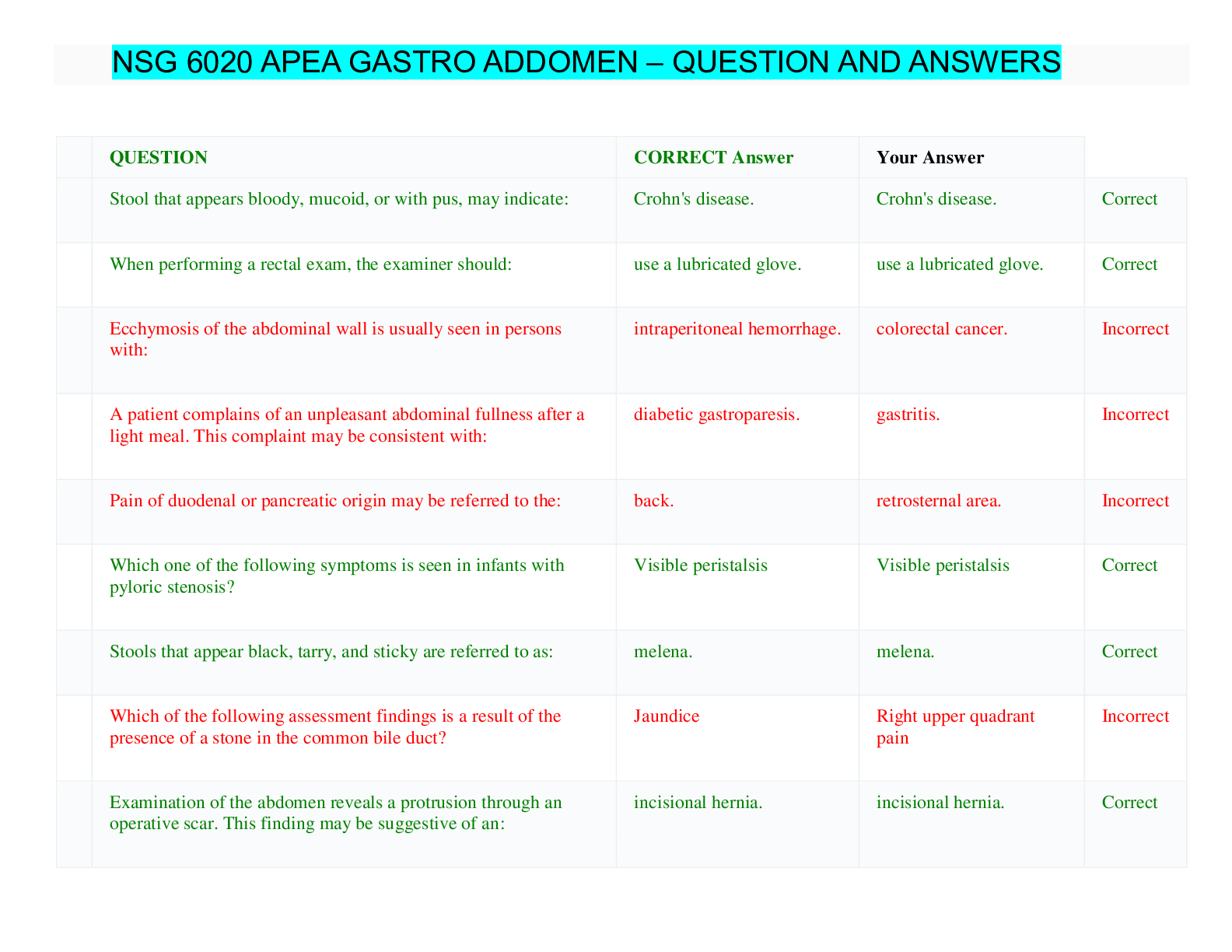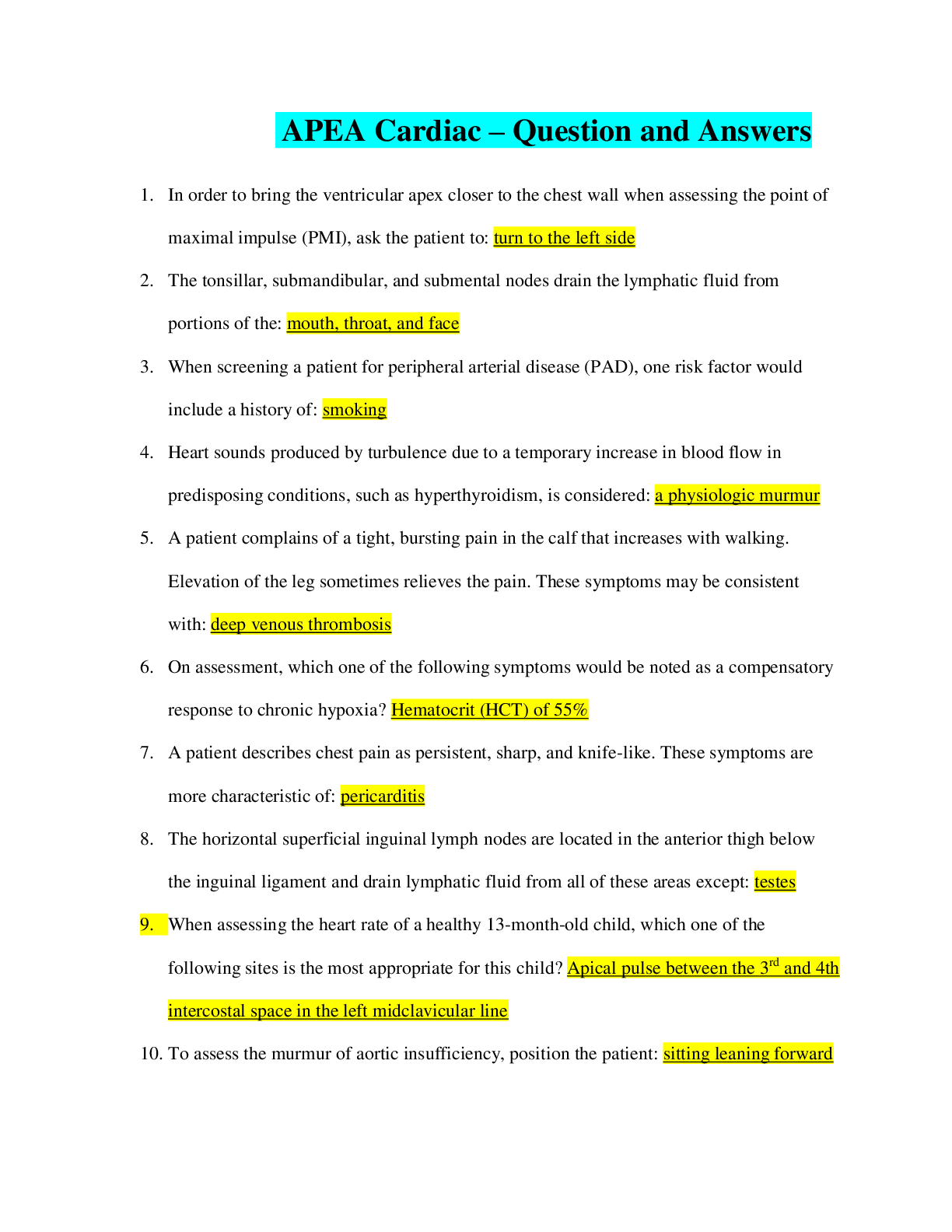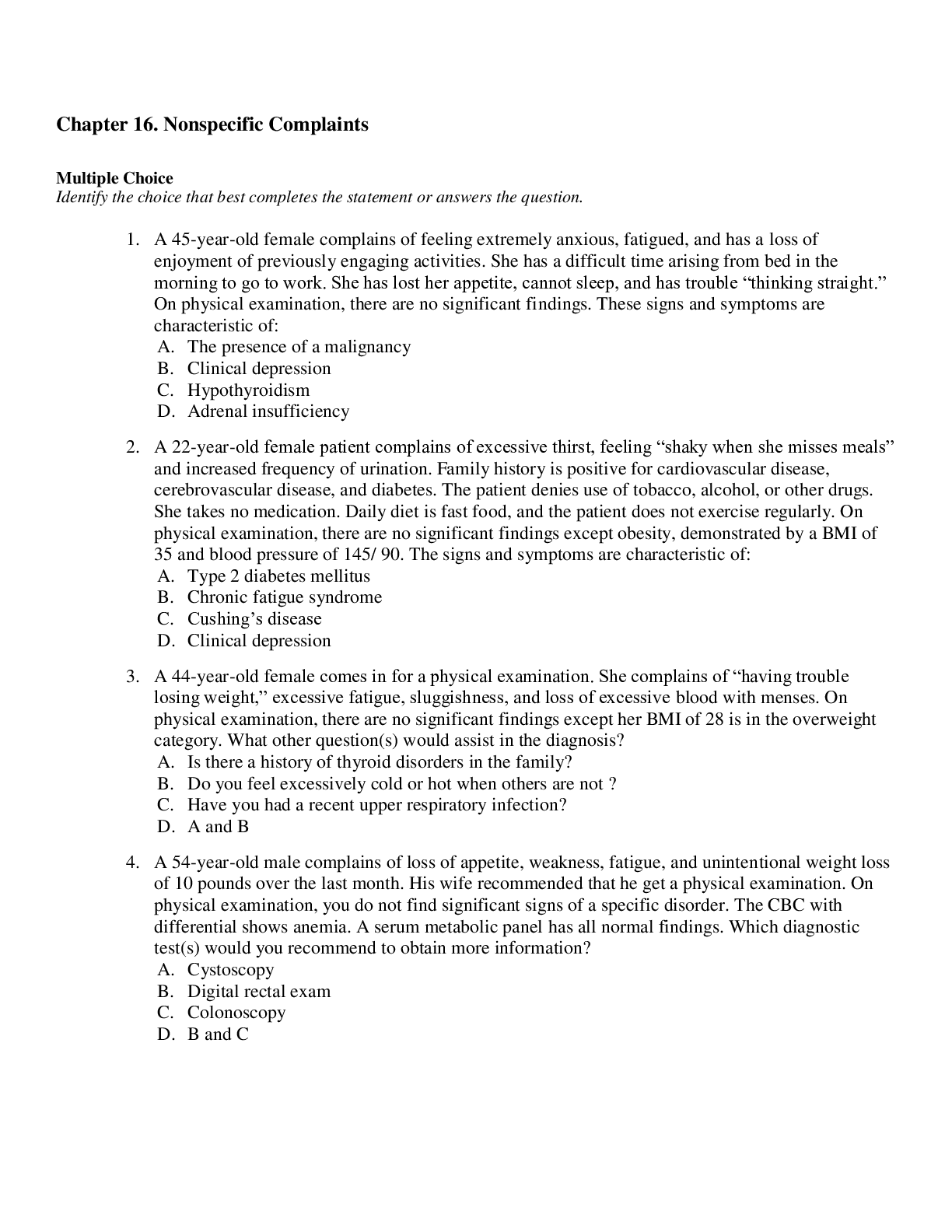*NURSING > QUESTIONS & ANSWERS > NUR 2212 ADVANCED Med surge Burns Review Questions & Answers. (All)
NUR 2212 ADVANCED Med surge Burns Review Questions & Answers.
Document Content and Description Below
NUR 2212 ADVANCED Med surge Burns Review Questions & Answers. The nurse is assessing a client with severe burn wounds. What are the nursing interventions performed by the nurse in the order of prio... rity? 1. Checking for a patent airway 2. Maintaining effective circulation 3. Performing adequate fluid replacement 4. Caring for the burn wound A client is severely injured with burns and sustained major trauma from a fire incident. What is the order of assessments according to priority in this situation? 1. Using a jaw-thrust maneuver to establish an airway 2. Providing bag-valve-mask (BVM) ventilation 3. Palpating for the presence of a radial pulse 4. Monitoring systolic blood pressure 5. Assessing the score of eye opening 6. Removing the clothing with scissors The nurse is assessing a client with burns over 15% of the body. Which priority nursing action should be taken to ensure a complete assessment? 1 Determining the level of mobility 2 Removing the clothes of the client 3 Placing the client in recumbent position 4 Cleaning the wounds with antiseptic solution A registered nurse teaches a new orienting nurse about interventions to be followed for a client with burns due to inhalation injury. Which statement made by the new orienting nurse indicates the new nurse needs more orientation? 1 "I should administer intravenous analgesia." 2 "I should check pulses distal to burns." 3 "I should prepare for an endotracheal intubation." 4 "I should anticipate the need for fiberoptic bronchoscopy." analgesia. The nurse should anticipate both endotracheal intubation and a need for fiberoptic bronchoscopy. The nurse teaches a client about strategies to reduce burn injuries. Which statement made by the client indicates the need for further teaching? 1 "I should never smoke in bed." 2 "I should never use gasoline to start a fire." 3 "I should never leave hot oil unattended while cooking." 4 "I should never attend to burning candles near open curtains." A client is admitted to the hospital due to electrical burns. Which assessment findings does the nurse anticipate? Select all that apply. 1 Coughing 2 Burn odor 3 Smoky breath 4 Leathery skin 5 Cardiac arrest A client who sustained burn injuries due to a fire and explosion has a carbon monoxide level of 14%. Which pathophysiologic risk is increased in the client? 1 Stupor 2 Vertigo 3 Convulsions 4 Slight breathlessness The nurse is caring for a client with a burn injury and suspects atelectasis and hypoxia. Which age-related changes should the nurse associate these findings? 1 Reduced mobility 2 Reduced healing time 3 Reduced thoracic compliance 4 Reduced inflammatory and immune responses A client with burns is hospitalized in the emergency department and advised to get an electrocardiogram (ECG) done. Which type of burn injury has the client most likely sustained? 1 Flame burn 2 Chemical burn 3 Electrical burn 4 Radiation burn A client with burns caused by flames is hospitalized. Which specific emergency burn management would be appropriate for this client? 1 Removing all metal objects 2 Helping the client bathe or shower 3 Initiating cardiopulmonary resuscitation 4 Administering tetanus toxoid for prophylaxis While caring for a client with a burn injury and in the resuscitation phase, the nurse notices that the client is hoarse and produces audible breath sound on exhalation. Which immediate action would be appropriate for the safe care of the client? Select all that apply. 1 Providing oxygen immediately 2 Notifying the rapid response team 3 Considering it a normal observation 4 Initiating an intravenous (IV) line and beginning fluid replacement 5 Obtaining an electrocardiogram (ECG) of the client The nurse is caring for a client with burns receiving opioid analgesics and who is sedated. Which medications should the nurse anticipate to be prescribed by the primary healthcare provider to overcome this side effect of the opioid analgesics? Select all that apply. 1 Morphine 2 Pregabalin 3 Lorazepam 4 Midazolam 5 Gabapentin The registered nurse is teaching the student nurse about precautions to take when treating a client with open burn wounds. Which statement made by the student nurse indicates the need for further teaching? 1 I should use non-sterile gloves when applying ointments." 2 "I should use non-sterile, disposable gloves when removing old dressings." 3 "I should wear personal protective equipment before caring for the client." 4 "I should remove personal protective equipment before leaving one client to treat another." Which wound care is given to a client with severe burn injuries during the acute phase? 1 Assess extent and depth of burns 2 Provide daily shower and wound care 3 Remove dead and contaminated tissue 4 Assess the wound daily and adjust the dressing The registered nurse is teaching a student nurse about the ongoing monitoring of a client with electrical burns. Which statement made by the student nurse indicates the need for further teaching? 1 "I should monitor the airway." 2 "I should monitor the eye pH." 3 "I should monitor vital signs." 4 "I should monitor urine output." A client has burn injuries sustained from an electrical current. What are the interventions to follow until the client is transferred to the primary healthcare center? Select all that apply. 1 Cover the burns with ice. 2 Leave the adherent clothing in place. 3 Wrap the client in a dry clean sheet. 4 Remove as much burned clothing as possible. 5 Immerse the burned body part in cool water. A client was admitted with a burn injury caused by a quick heat flash. The nurse examined the skin and noticed erythema and mild swelling. What type of burn does the nurse suspect? 1 First-degree burn 2 Third-degree burn 3 Fourth-degree burn 4 Second-degree burn A man who has 40% of the body surface area burned is admitted to the hospital. Fluid replacement of 7200 mL during the first 24 hours has been prescribed. Fifty percent of fluid replacement should be administered in the first 8 hours; then the remaining 50% given over the next 16 hours. What does the nurse calculate the hourly intravenous (IV) fluid to be for the first 8 hours of fluid replacement therapy? Record your answer using a whole number. ___ mL/hr A healthcare provider prescribes 2 liters of intravenous (IV) fluid to be administered over 12 hours to a client who sustained a burn injury. The drop factor of the tubing is 10 gtts/mL. The nurse should set the flow rate at how many drops per minute? Record your answer using a whole number. ___ gtts/min A client is admitted for treatment of partial- and full-thickness burns of the entire right lower leg extremity and the anterior portion of the right upper arm. A nurse performs an immediate appraisal of the percentage of body surface area burned using the rule of nines. What percentage of body surface area does the nurse determine is affected? Record the answer to one decimal place. _______% A nurse is using the rule of nines to estimate burn injury in a client. The client has burns on the front chest, front abdomen, both sides of both upper extremities, and entire head. Calculate the percentage of body surface burned. Record your answer as a whole number. ______% Following a fire, the disaster management team assesses burn injuries of the survivors. The team finds that most survivors have pink to cherry red skin with blisters. Which type of burns does the nurse identify on the survivors? 1 First degree burns 2 Third degree burns 3 Fourth degree burns 4 Second degree burns While the nurse was caring for a client with chemical burns after a factory explosion, there was increased edema in the surrounding tissues. What might have led to increased edema? 1 Stabilizing the cervical spine 2 Lowering burned limbs below the heart 3 Brushing dry chemical from skin before irrigation 4 Flushing chemical from wound with saline solution A client who is recovering from deep partial-thickness burns develops chills, fever, flank pain, and malaise. The primary healthcare provider makes a tentative diagnosis of urinary tract infection. Which diagnostic tests should the nurse expect the primary healthcare provider to prescribe to confirm this diagnosis? 1 Cystoscopy and bilirubin level 2 Specific gravity and pH of the urine 3 Urinalysis and urine culture and sensitivity 4 Creatinine clearance and albumin/globulin (A/G) ratio A client who experienced extensive burns is receiving intravenous fluids to replace fluid loss. The nurse should monitor for which initial sign of fluid overload? 1 Crackles in the lungs 2 Decreased heart rate 3 Decreased blood pressure 4 Cyanosis The nurse is caring for a client who has been admitted with partial- and full-thickness burns over 25% of the total body surface area. Lactated Ringer solution and 5% dextrose have been prescribed. What is the purpose of these fluids? 1 Prevent fluid shifts 2 Expand the plasma 3 Maintain blood volume 4 Replace electrolytes lost A nurse is caring for a client during the emergent phase of a severe burn injury. Which parenteral intervention prescribed by the healthcare provider should the nurse question? 1 Colloids 2 Potassium 3 Hypertonic saline 4 Lactated Ringer solution A client is admitted to the hospital with deep partial-thickness burns to both hands and forearms after an accident. How should the nurse apply the prescribed antimicrobial medication? 1 Place the medication directly on the dressing in a thick layer using clean gloves. 2 Place the medication directly on the burn wound in a thin layer using sterile gloves. 3 Put the medication in a Hubbard tank and saturate sterile dressings with it before applying the dressings to the burns. 4 Put the medication in a Hubbard tank and allow the client to soak in the tank for several minutes every day. The nurse is caring for a client with wound dressings to the burns on 55% of the body. The dressing changes are very painful, and the client rates them 7/10 on the pain scale. The client has morphine 2 mg to be administered by mouth every 2 hours as needed. When planning the client's care, when does the nurse decide to administer the medication? 1 15 minutes before the dressing change 2 60 minutes before the dressing change 3 Along with a stool softener each time it is administered 4 Only if the client rates pain between 8 and 10 on the pain scale A nurse is administering a histamine H2antagonist to a client who has extensive burns. The nurse explains to the client that this drug is given prophylactically during the first few weeks after extensive burns. What complication of burns will it prevent? 1 Colitis 2 Gastritis 3 Stress ulcer 4 Metabolic acidosis A nurse is assessing the adequacy of a client's intravenous fluid replacement therapy during the first 2 to 3 days after sustaining full-thickness burns to the trunk and right thigh. What assessment will provide the nurse with the most significant data? 1 Weights every day 2 Urinary output every hour 3 Blood pressure every 15 minutes 4 Extent of peripheral edema every 4 hours A client is rescued from a house fire and arrives at the emergency department 1 hour after the rescue. The client weighs 132 pounds (60 kilograms) and is burned over 35% of the body. The nurse expects that the amount of lactated Ringer solution that will be prescribed to be infused in the next 8 hours is what? 1 2100 mL 2 4200 mL 3 6300 mL 4 8400 mL A client sustains severe burns over 40% of the surface area of the body. The nurse is assigned to care for the client during the first 48 hours after the injury. What clinical finding does the nurse anticipate if the client develops water intoxication? 1 Sooty-colored sputum 2 Frothy, pink-tinged sputum 3 Disorientation with twitching 4 Urine output of 25 mL/hr A client is admitted to the burn unit with partial-thickness burns over 30% of the body surface area. Twenty-four hours later, the client, who has an intravenous (IV) line of 5% dextrose in saline running, has tremors, twitching, and signs of disorientation. During the past hour the urinary output was 110 mL. What should the nurse do next? 1 Slow the IV rate and notify the healthcare provider. 2 Slow the IV rate and check the last chest x-ray film. 3 Increase the IV rate and assess the arterial blood gases. 4 Increase the IV rate and request a prescription for calcium gluconate. A client is admitted with 50% of the body surface area burned after an industrial explosion and fire. The client's serum albumin is 1.5 g/dL (150 mg/dL), the hematocrit is 30%, the urine specific gravity is 1.025, and the serum globulin is 3 g/dL (300 mg/dL). When evaluating the client's response to fluid replacement, what determines when the nurse should prepare to administer a colloid? 1 Globulin is 3 g/dL (300 mg/dL) 2 Albumin is below 2 g/dL (200 mg/dL) 3 Hematocrit is below 32% 4 Urine specific gravity is 1.018 A client who is recovering from deep partial-thickness burns develops chills, fever, flank pain, and malaise. The primary healthcare provider makes a tentative diagnosis of urinary tract infection. Which diagnostic tests should the nurse expect the primary healthcare provider to prescribe to confirm this diagnosis? 1 Cystoscopy and bilirubin level 2 Specific gravity and pH of the urine 3 Urinalysis and urine culture and sensitivity 4 Creatinine clearance and albumin/globulin (A/G) ratio A client is admitted with 50% of the body surface area burned. The nurse caring for the client 48 hours after admission reviews the client’s laboratory results: urine specific gravity, 1.015; urine output, 50 mL/hr; hematocrit, 42 (0.42 volume fraction); albumin, 3.6 g/dL (36 g/L); and pulmonary arterial wedge pressure, 10 mm Hg. Which conclusion will the nurse draw based upon the laboratory results? 1 Albumin is critically low. 2 Fluid therapy is successful. 3 Kidney failure is impending. 4 Hemoconcentration is occurring. An older adult client is brought to the hospital by a family member because of deep partial-thickness burns on the arms and hands. The client protests being hospitalized and asks, "Why can’t I just go home and have my spouse care for me?" What is the best response by the nurse? 1 "You sound upset, but your primary healthcare provider knows best. You should do what is prescribed." 2 "Your spouse is very capable, but if your burns get infected, a family member can’t give you the injections you will need." 3 "Your burns are more serious than you think, and we have specially trained people here just to take care of you." 4 "You may heal more slowly because of your age, and you may need the special care and equipment available in the hospital." A client who was hospitalized with partial- and full-thickness burns over 30% of the total body surface area is to be discharged. The client asks the nurse, "How will my spouse be able to care for me at home?" How should the nurse interpret this statement? 1 Readiness to discuss the client’s deformities 2 Indication of a change in family relations 3 Need for more time to think about the future 4 Beginning realization of implications for the future The nurse is caring for a client with burns and reviews the client’s laboratory results: blood urea nitrogen (BUN), 30 mg/dL (10.2 mmol/L); creatinine, 2.4 mg/dL (184 mcmol/L); serum potassium, 6.3 mEq/L (6.3 mmol/L); pH, 7.1; Po2, 90 mm Hg; and hemoglobin (Hgb), 7.4 g/dL (74 mmol/L). Which condition does the nurse suspect the client has based upon these findings? 1 Azotemia 2 Hypokalemia 3 Metabolic alkalosis 4 Respiratory alkalosis A client’s extensive burns are being treated with silver nitrate 0.5% dressings. A week after treatment is begun, the nurse identifies that the client’s sodium level is 135 mEq/L (135 mmol/L) and the potassium level is 3.0 mEq/L (3.0 mmol/L). The nurse notifies the primary healthcare provider. Which prescription should the nurse be prepared to administer? 1 Add potassium chloride (KCl) to the existing intravenous (IV) lactated Ringer solution. 2 Add sodium chloride (NaCl) to the existing IV lactated Ringer solution. 3 Discontinue the IV NaCl with 20 mEq KCl solution and replace with IV 5% D5W solution. 4 Discontinue the IV 5% D5W with 40 mEq KCl solution and replace with IV 5% D5W solution. A client is burned on the anterior part of both legs, from the knees to the feet. The nurse uses the rule of nines to assess the percentage of total body surface area (TBSA) burned. Which percentage should the nurse document in the client’s hospital record? 1 9% 2 18% 3 27% 4 36% When changing the dressings on deep partial-thickness burns on a client’s hand, the nurse should use which type of gauze and which technique? 1 Cotton-backed; fully extending the fingers with thumb in opposition 2 Non–cotton-backed; placing a hand roll with fingers slightly flexed 3 Non–cotton-backed; extending fingers fully with gauze between each finger 4 Cotton-backed; a hand roll, with fingers completely flexed and thumb in opposition A nurse determines that a client in the acute phase of burns has eaten only a small portion of each meal. What should the nurse assess for in this client? 1 Dehydration 2 Dry brittle hair 3 Prolonged wound healing 4 Clubbing of the fingertips A client has a diagnosis of partial-thickness burns. While planning care, the nurse recalls that the client’s burn is different than full-thickness burns. Which information did the nurse recall? 1 Partial-thickness burns require grafting before they can heal. 2 Partial-thickness burns are often painful, reddened, and have blisters. 3 Partial-thickness burns cause destruction of both the epidermis and dermis. 4 Partial-thickness burns often take months of extensive treatment before healing. A client has a diagnosis of superficial partial-thickness burns. The client asks what layers of skin are involved with this type of burn. Which response by the nurse is most appropriate? 1 The epidermis is damaged. 2 The dermis is damaged partially. 3 The structures beneath the skin are destroyed. 4 Both the epidermis and the dermis are destroyed. A client is admitted to the hospital after sustaining serious burns that involve a large surface of the skin. The nurse is caring for the client during the emergent phase after the injury. Which nursing objective is the priority during this phase? 1 Alleviating pain 2 Preventing infection 3 Replacing blood loss 4 Restoring fluid volume A person sustains severe burns of the arms and is waiting for emergency services to arrive. A nurse bystander responds to the scene. Another bystander is getting ready to apply butter to the burns, stating that it will provide soothing relief. Which response by the nurse is best? 1 "Let’s focus on sitting quietly with the victim while waiting for the ambulance." 2 "Let’s cover up the victim with one of those tablecloths instead." 3 "Let’s apply first aid cream to the burns rather than the butter." 4 "Let’s get that butter on quickly." A client receives an autograft for a severe burn and is taught how to change the dressing. One week after receiving the graft, the client identifies that the edges of the graft are curling up and asks the nurse about it. Which is the best response by the nurse? 1 "May I take a look at it?" 2 "It’s time for another graft." 3 "Is there any sign of redness?" 4 "It is supposed to curl up at the edges." A client with 35% of total body surface area burned in a fire is now 48 hours postburn. The nurse concludes that the client is moving from the emergent to the acute phase of burn management. Which finding supports the nurse’s conclusion? 1 Hypokalemia 2 Hypoglycemia 3 Decreased blood pressure 4 Increased urine specific gravity A severely burned client has been hospitalized for 3 days and is now in the acute phase. Until now recovery has been uneventful, but the client begins to exhibit extreme restlessness. What does the nurse conclude the client is most likely developing? 1 Kidney failure 2 Cerebral hypoxia 3 Metabolic acidosis 4 Hypovolemic shock A nurse is assessing a client during the first 24 hours after a burn injury. Which sign indicates to the nurse that fluid replacement therapy is adequate? 1 Decreasing central venous pressure (CVP) readings 2 Hematocrit level increasing from 50% to 55% 3 Slowing of a previously rapid pulse 4 Urinary output of 15 to 20 mL/hr A nurse is caring for a client during the first few hours after admission to the burn unit with full-thickness burns of the trunk and head. Which nursing goal is the priority during the emergent phase of a burn injury? 1 Preventing pain 2 Managing leukopenia 3 Preventing infection 4 Managing fluid loss What should the nurse consider when providing care to a client in the acute phase of treatment for a full-thickness burn? 1 The risk of septicemia and its potential complications from treatment 2 The risk of psychosocial adjustments and resuming previous roles 3 The risk of oral mucous membrane injury and its associated risks 4 The risk of insufficient community resources and emotional support The nurse is assessing a client 12 hours after the client sustained a deep partial-thickness burn on the forearm. What characteristics should the nurse expect to identify when assessing the injured tissue? 1 Painful and reddish-white 2 Pinkish and tender 3 Charred and white 4 Leathery and black The nurse is evaluating the condition of a client with burns of the upper body. Which finding will alert the nurse of a potential respiratory obstruction? 1 Deep breathing 2 Hoarse quality to the voice 3 Pink-tinged, frothy sputum 4 Rapid abdominal breathing A client sustains full-thickness and deep partial-thickness burns. The client asks, "What is the difference between my full-thickness and deep partial-thickness burns?" Which information will the nurse share with the client? 1 Full-thickness burns extend into the subcutaneous tissue; deep partial-thickness burns affect only the epidermis. 2 Full-thickness burns involve superficial layers of the epidermis; deep partial-thickness burns extend through the epidermis. 3 Full-thickness burns extend through the epidermis and only part of the dermis; deep partial-thickness burns extend into the subcutaneous tissue. 4 Full-thickness burns extend into the subcutaneous tissue; deep partial-thickness burns extend through the epidermis and involve only part of the dermis. A nurse is caring for a client who is scheduled to have a pigskin graft applied to a burned area. Which type of graft will the nurse provide information about to the client? 1 Isograft 2 Allograft 3 Homograft 4 Heterograft A nurse is caring for a client who sustained a partial-thickness burn to the lower leg accounting for 5% of the total body surface area 1 day ago. Which primary short-term outcome established by the nurse and client will be added to the care plan? 1 The client’s airway will remain patent. 2 The client’s burns will heal free of infection. 3 The client’s urine output will exceed 30 mL every hour. 4 The client’s pain will remain at 2 or less on a scale of 0 to 10. A client with third-degree burns asks a nurse, "Why do I need a temporary pigskin graft?" What is the nurse’s best response? 1 "It helps debride necrotic tissue." 2 "It promotes rapid healing of the wound." 3 "When sutured in place, it provides better adherence." 4 "Topical lotions can be used concurrently with the graft." Two days after a severely burned client is admitted to the hospital, the client begins to exhibit restlessness. Which condition does the nurse determine the client is most likely developing? 1 Renal failure 2 Hypervolemia 3 Cerebral hypoxia 4 Metabolic acidosis A client’s burn wounds are scheduled to be debrided mechanically. Which equipment will the nurse prepare? 1 Enzymatic agents 2 Scissors and forceps 3 Autolytic semi-occlusive dressing 4 Continuous passive-motion device A nurse is caring for a client with severe burns. The nurse determines that this client is at risk for hypovolemic shock. Which physiologic finding supports the nurse’s conclusion? 1 Decreased rate of glomerular filtration 2 Excessive blood loss through the burned tissues 3 Plasma proteins moving out of the intravascular compartment 4 Sodium retention occurring as a result of the aldosterone mechanism A nurse is caring for a client who had a skin graft applied over a full-thickness burn on the chest. Which observation of the donor site during the first 24 hours after surgery should the nurse report to the primary healthcare provider immediately? 1 Small amount of yellowish green oozing 2 Moderate area of serosanguineous oozing 3 Epithelialization under the nonadherent dressing 4 Separation of the edges of the nonadherent dressing A burn client is receiving the open method for wound treatment. Which information will the nurse explain to the client? 1 Bathing will not be permitted. 2 Dressings will be changed daily. 3 Personal protective equipment will be worn by staff. 4 Room temperature will be kept below 72° F (22.2° C). A client rescued from a burning building has partial- and full-thickness burns over 40% of the body. Which initial physiologic change will the nurse expect? 1 An increase in blood volume 2 An increase in serum potassium 3 A decrease in capillary permeability 4 A decrease in urinary specific gravity A burn victim has waxy white areas interspersed with pink and red areas on the anterior trunk and all of both arms. The nurse calculates the percentage of total body surface area (TBSA). Which percentage will the nurse report? 1 20 2 25 3 30 4 36 A client was admitted with full-thickness burns 2 weeks ago. Since admission, the client has lost an average of 1 lb (0.5 kg) of weight each day. Which action will the nurse most likely take based upon the adjusted dietary plan? 1 Provide low-sodium milk. 2 Provide high-protein drinks. 3 Provide foods that are low in potassium. 4 Provide 10% more calories in the form of fats. A client who sustained a burn injury involving 36% of the body surface area is receiving hydrotherapy. Which is the best nursing intervention when providing wound care? 1 Use a consistent approach to care and encourage participation. 2 Prepare equipment while doing the procedure and explain the treatment to the client. 3 Rinse the burn area with 105° F (40.6° C) water to prevent loss of body temperature. 4 Arrange for a change of staff every 4 to 5 days and have the client select the time for the procedure to be done. A client who sustained serious burns now has a stress ulcer. Which clinical indicators of shock should the nurse immediately report to the primary healthcare provider? Select all that apply. 1 Weakness 2 Diaphoresis 3 Tachycardia 4 Cold extremities 5 Flushed skin tone A client with a full-thickness burn receives an allograft. Several days later the client points out that the graft is coming off at the edges. What is the nurse’s best response? 1 "It is a temporary graft; it is expected to fall off." 2 "You must have pulled it loose; I’ll notify your primary healthcare provider." 3 "An infection may be starting; I anticipate that antibiotics will be prescribed." 4 "It is a permanent graft; it is likely that it will need to be replaced." A client with burns tells the nurse that the primary healthcare provider stated that skin grafts would be required. The client asks when the procedure will be performed. Which response by the nurse is most appropriate initially? 1 "The procedure will be performed within 7 days." 2 "It depends on when you are rid of all signs of infection." 3 "The graft procedure will be done as soon as scar formation occurs." 4 "Tell me what your primary healthcare provider said about the graft procedure." A client is recovering from full-thickness burns, and the nurse provides counseling on how to best meet nutritional needs. Which client food selections indicate to the nurse that the client understands the teaching? 1 Cheeseburger and a milkshake 2 Beef barley soup and orange juice 3 Bacon and tomato sandwich and tea 4 Chicken salad sandwich and soft drink Which nursing action is most important to promote the nutritional status of a client during the acute phase of treatment after extensive burns? 1 Provide a diet high in sodium. 2 Limit caloric intake to decrease the work of the body. 3 Reduce protein intake to avoid overtaxing the kidneys. 4 Administer the prescribed intravenous fluid with the added vitamin C. A nurse is evaluating a client’s fluid loss resulting from extensive burns. Which laboratory result will the nurse check? 1 Blood urea nitrogen (BUN) 2 Sedimentation rate 3 Hematocrit (Hct) 4 Blood pH A nurse is caring for a client with full-thickness burns of the anterior trunk and thigh. The nurse is monitoring fluid balance during the first 2 to 3 days after the burn. Which area is most important for the nurse to assess for fluid balance in this client? 1 Weight every day 2 Urinary output every hour 3 Blood pressure every 15 minutes 4 Extent of peripheral edema every 4 hours A client is admitted to the hospital for the medical management of burns over 18% of the body’s surface. What should the nurse teach the client to help manage pain during dressing changes? 1 Deep breathing exercises 2 Progressive muscle relaxation 3 Active range-of-motion exercises 4 Important elements of wound care A client is admitted with severe burns. The nurse is caring for the client 36 hours after the client’s admission and identifies the client’s potassium level of 6.0 mEq/L (6.0 mmol/L). Which drink will the nurse recommend be included in the client’s diet? 1 Milk 2 Tea 3 Orange juice 4 Tomato juice A client with burns over 35% of the body reports chilling. Which action will the nurse take to promote client comfort? 1 Limit room drafts. 2 Place a sterile top sheet over the client. 3 Decrease the room humidity below 10%. 4 Maintain an 80° F (26.7° C) room temperature. A nurse is teaching a safety class about burns. Which examples will the nurse use to describe occupational hazards for burn injuries? Select all that apply. 1 Tar 2 Power lines 3 Fertilizers In4 Radiators 5 Outdoor grills What is a clinical manifestation of hypernatremia in burns? 1 Fatigue 2 Seizures 3 Paresthesias In4 Cardiac dysrhythmias Arrange the order of airway management in a client with burns. 1. Intubate the client within 1 to 2 hours after injury. 2. Place the client on ventilatory support. In 3. Escharotomies of the chest wall, if necessary. In 4. Extubation is indicated when edema resolves. 5. A client is admitted with severe burns, is obese, and has pre-existing respiratory problems. Which complication should the nurse anticipate? 1 Necrosis In2 Pneumonia 3 Dysrhythmias 4 Venous thromboembolism What is an example of third spacing in a burn injury? 1 Blister formation 2 Edema formation 3 Fluid mobilization A nurse is assessing a client with second-degree burns. The shaded areas in the illustration indicate the parts of the body where the client sustained burns. Calculate the percentage of the body that was burned using the rule of nines. The nurse is caring for a client 4 days after the client was admitted to the hospital with burns on the trunk and arms. The nurse collaborates with the dietician to develop a dietary plan for the following day. Which plan will the nurse follow? 1 High caloric intake, liberal potassium intake, and 3 g protein/kg/day 2 High caloric intake, restricted potassium intake, and 1 g protein/kg/day 3 Moderate caloric intake, liberal potassium intake, and 3 g protein/kg/day 4 Moderate caloric intake, restricted potassium intake, and 1 g protein/kg/day [Show More]
Last updated: 2 years ago
Preview 1 out of 24 pages

Buy this document to get the full access instantly
Instant Download Access after purchase
Buy NowInstant download
We Accept:

Reviews( 0 )
$16.00
Can't find what you want? Try our AI powered Search
Document information
Connected school, study & course
About the document
Uploaded On
May 12, 2020
Number of pages
24
Written in
Additional information
This document has been written for:
Uploaded
May 12, 2020
Downloads
0
Views
118

